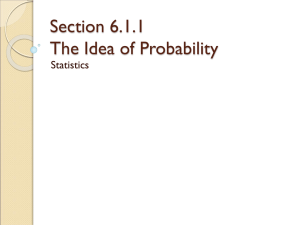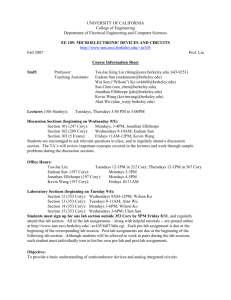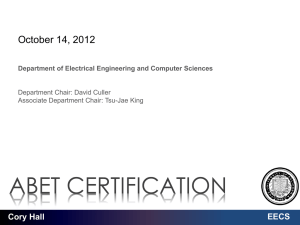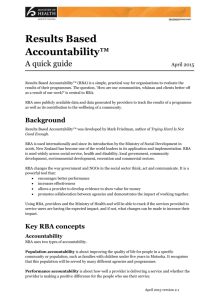lecture1
advertisement
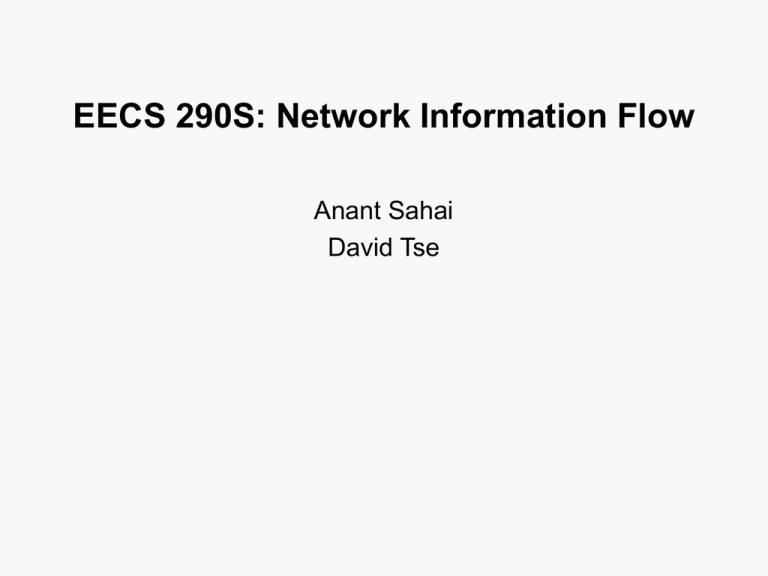
EECS 290S: Network Information Flow Anant Sahai David Tse Logistics • Anant Sahai: 267 Cory (office hours in 258 Cory), sahai@eecs. Office hours: Mon 4-5pm and Tue 2:30-3:30pm. • David Tse, 257 Cory (enter through 253 Cory), dtse@eecs. Office hours: Tue 10-11am, and Wed 9:30-10:30am. • Prerequisite: some background in information theory, particularly for the second half of the course. • Evaluations: – – – – Two problem sets (10%) Take-home midterm (15%) In-class participation and a lecture (25%) Term paper/project (50%) Logistics • Text: – Raymond Yeung, Information Theory and Network Coding, preprint available at http://iest2.ie.cuhk.edu.hk/~whyeung/post/main2.pdf. – Papers • References – T. Cover and J. Thomas, Elements of Information Theory, 2nd edition. Classical Information Theory • • • • • A Mathematical Theory of Communication 1948 Source has entropy rate H bits/sample. Channel has capacity C bits/sample. Reliable communication is possible iff H < C. Information is like fluid passing through a pipe. How about for networks? General Problem • Each source is observed by some nodes and needs to be sent to other nodes • Question: Under what conditions can the sources be reliably sent to their intended nodes? Simplest Case D S • Single-source-single-destination (single unicast flow) • All links are orthogonal and non-interfering (wireline) C = m incut ( S; D ) (Ford-Fulkerson 1956) • Applies to commodities or information. • Applies even if each link is noisy. • Fluid through pipes analogy still holds. Extensions • More complex traffic patterns • More complex signal interactions. Multicast • Single source needs to send the same information to multiple destinations. s b1 • What choices can we make at node w? t • Or can it? b1 b2 w b1 • One slave cannot serve two masters. b2 u b2 x y z Multicast • Picking a single bit does not achieve the min-cut of both destinations s b1 t b2 b1 b2 w b1 b1 u b2 x y b 1 b1 z Network coding • Needs to combine the bits and forward equations. s • Each destination collects all the equations and solves for the unknown bits. b1 t b2 b1 b2 w b1 • Can achieve the min-cut bound simultaneously for both destinations. b1 + b 2 u b2 x y b +b 1 2 b1 + b 2 z Other traffic patterns • Multiple sources send independent information to the same destination. • Single source sending independent information to several destinations. • Multiple sources each sending information to their respective destinations. • The last two problems are not easy due to interference Complex Signal Interactions: Wireless Networks D S relays • Key properties of wireless medium: broadcast and superposition. • Signals interact in a complex way. • Standard physical-layer model: linear model with additive Gaussian noise. Gaussian Network Capacity: Known Results Tx Rx point-to-point (Shannon 48) C = log2 (1 + SNR) Tx 1 Rx1 Rx Tx 2 multiple-access (Alshwede, Liao 70’s) Tx Rx 2 broadcast (Cover, Bergmans 70’s) (Weintgarten et al 05) What We Don’t Know Unfortunately we don’t know the capacity of most other Gaussian networks. Tx 1 Rx 1 Tx 2 Rx 2 Interference (Best known achievable region: Han & Kobayashi 81) Relay S relay D (Best known achievable region: El Gamal & Cover 79) Bridging between Wireline and Wireless Models • There is a huge gap between wireline and Gaussian channel models: – signal interactions – Noise • Approach: deterministic channel models that bridge the gap by focusing on signal interactions and forgoing the noise. Two-way relay example 1) A b1 R B R 2) 3) 4) A A A R b1 R b2 b2 B RAB=RBA=1/4 B B Network coding exploits broadcast medium 1) A b1 R B R 2) A b2 B b1b2 3) A B RAB=RBA=1/3 Nature does the coding via superposition 1) A b1 b1b2 b2 B b1b2 2) A B RAB=RBA=1/2 But what happens when the signal strengths of the two links are different?
